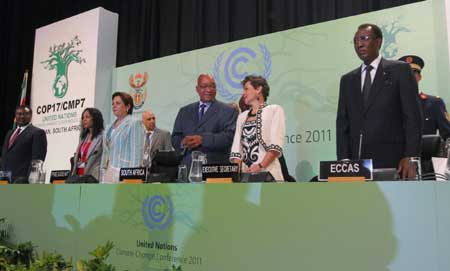 |
|
South African President Jacob Zuma and UNFCCC Executive Secretary Figueres await the opening plenary session of COP17 in Durban.(Agencies) |
|
Several animal species including gorillas in Rwanda and tigers in Bangladesh could risk extinction if the impact of climate change and extreme weather on their habitats is not addressed, a UN report showed on Sunday. Launched on the sidelines of global climate negotiations in Durban, the report by the United Nations Food and Agriculture Organisation shows how higher temperatures, the rise in sea levels, deforestation and excessive land use have damaged the habitats of certain species, especially in Africa. "Many ecosystems have already been stressed by increasing population, historical and recent deforestation, unsustainable management practices and even invasive species," Eduardo Rojas-Briales, assistant director general at the FAO's forestry department, said at the launch of the report. The most affected areas include mountains, isolated islands and coastal areas, which limit the possibilities for animals to migrate elsewhere and create new habitats. "The remaining populations become enclosed in very small ecosystems, they have inbreeding problems ... and at the end these species may disappear," he added. Other examples of affected animals included elephants in Mali, lions in the Serengeti and crocodiles in Malawi. The report said an estimated 20-30 percent of plant and animal species will be at higher risk of extinction due to global warming and a significant proportion of endemic species may become extinct by 2050 as a consequence. Other consequences could include the spread of invasive species and infectious diseases, it said. The report urges more focus on restoration of damaged ecosystems, especially those key to tackling climate change such as mangroves, inland waters, forests, savannahs and grasslands. The FAO also called for the creation of migration corridors for animals in areas where their movement was constrained. The organisation said while more resources were flowing to biodiversity conservation, more action at the government and policy level was needed. It also urged local communities to develop projects that mitigate the impact of climate change on wildlife, naming eco-tourism activities as an example. (Read by Emily Cheng. Emily Cheng is a journalist at the China Daily Website.) (Agencies) |
联合国上周日公布的一份报告显示,如果气候变化和极端天气对其栖息地的影响无法解决,包括卢旺达大猩猩和孟加拉虎在内的多种动物都将面临灭绝。 联合国粮农组织的这份报告指出了气温升高、海平面升高、森林砍伐和土地滥用已如何破坏了一些物种的生存环境,特别是在非洲。这份报告也呼应了正在德班召开的全球气候变化磋商。 联合国粮农组织林业部的助理执行长爱德华多•罗哈斯-布里阿莱斯在报告发布时说:“很多生态体系都已经因为人口增长、以往和近期和森林砍伐、不可持续性的管理措施、甚至是入侵物种而不堪重负。” 受影响最严重的地区包括山区、孤岛、和沿海地区,这些地区限制了动物从其它地区迁徙过来和创造新的栖息地的可能性。 他补充说:“剩余群体隔绝在很小的生态体系内,存在近亲交配的问题,最后这些群体可能灭绝。” 其它受影响动物的例子包括马里的大象、(坦桑尼亚西北部)塞伦盖蒂平原的狮子,和马拉维的鳄鱼。 报告称,由于全球变暖,估计将有20%到30%的动植物物种灭绝风险很高,还有比例较高的地方性物种可能在2050年前灭绝。 报告指出,其它影响包括,外来入侵物种的扩散和传染病的传播。 报告敦促人们更加关注受损生态系统的恢复,特别是对于应对气候变化至关重要的物种,比如红树林、内陆水域、森林、非洲大草原和牧场草地。 联合国粮农组织还呼吁在那些动物迁徙受限的地区设立迁徙走廊。 该组织表示,尽管有更多的资源流向生物多样性保护,人们仍需在政府层面和政策层面采取更多措施。 该组织还敦促地方社区发展可以缓和气候变化对野生动植物影响的项目,比如生态旅游活动。 相关阅读 (中国日报网英语点津 Julie 编辑:陈丹妮) |
|
Vocabulary: on the sidelines: 当旁观者,不直接参加 population: 在此处指生物种群,生物群体 inbreeding: 使同系繁殖,近亲交配 endemic: 某地特有的,地方性的 savannah: 特指非洲大草原 |
